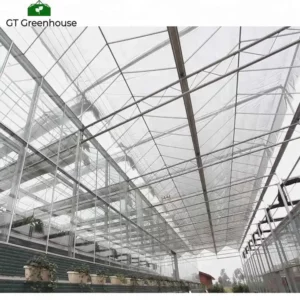Agricultural greenhouses, also known as commercial or production greenhouses, are controlled environments designed for the cultivation of crops and plants on a larger scale. These structures provide an enclosed space where environmental conditions such as light, temperature, humidity, and ventilation can be manipulated and optimized to facilitate plant growth and productivity. Agricultural greenhouses offer several benefits compared to traditional open-field farming, including extended growing seasons, protection from adverse weather conditions, and enhanced control over the growing environment.
Here are some key features and uses of agricultural greenhouses:
- Structure: Agricultural greenhouses are typically constructed using materials such as glass, polycarbonate, or plastic film that allow sunlight to enter while providing insulation and protection. The structure may vary from simple hoop houses or low tunnels to more sophisticated high-tech structures with advanced climate control systems.
- Climate Control: Greenhouses enable growers to manipulate environmental factors to create optimal conditions for plant growth. This includes controlling temperature, humidity, light levels, and air circulation using heating, cooling, ventilation, shading, and irrigation systems. Climate control allows year-round cultivation, protection against frost, and the ability to grow crops that may not be suited to the local climate.
- Crop Diversity: Agricultural greenhouses support the cultivation of a wide range of crops, including vegetables, fruits, herbs, flowers, and ornamental plants. The controlled environment allows for the production of high-value or specialty crops, off-season varieties, and exotic or tropical plants that may not thrive in the local climate.
- Pest and Disease Management: Greenhouses provide a physical barrier that helps protect plants from pests, insects, and certain diseases. By restricting the entry of external pests and using integrated pest management (IPM) techniques, growers can minimize the use of pesticides and maintain healthier crops.
- Improved Water Efficiency: Greenhouses often incorporate irrigation systems that optimize water usage and minimize water wastage. Techniques such as drip irrigation or hydroponics can be employed to deliver water directly to the plants’ root zones, reducing water consumption compared to traditional field irrigation methods.
- Research and Development: Agricultural greenhouses are vital for research, experimentation, and the development of new plant varieties, cultivation techniques, and crop improvement strategies. They provide controlled environments for studying plant physiology, testing new technologies, and investigating the effects of environmental factors on plant growth.
- Commercial Production: Greenhouses play a significant role in commercial agriculture, enabling year-round production and consistent crop yields. They provide opportunities for local food production, supply chain management, and meeting market demands for fresh produce regardless of seasonal limitations.
Overall, agricultural greenhouses offer a controlled and protected environment for crop production, allowing growers to optimize growing conditions, extend growing seasons, maximize yields, and enhance overall productivity and sustainability in agriculture.
Can you provide more information on integrated pest management (IPM) techniques used in agricultural greenhouses?
Integrated Pest Management (IPM) is an approach to pest management that combines multiple strategies to minimize the use of pesticides while effectively managing pests in agricultural greenhouses. IPM techniques aim to achieve long-term pest control by integrating biological, cultural, physical, and chemical control methods.
Here are some common IPM techniques used in agricultural greenhouses:
- Biological Control: Biological control involves using beneficial organisms to suppress pest populations. This includes the introduction of natural enemies such as predatory insects, parasitic wasps, or beneficial nematodes that prey on or parasitize pests. These organisms help keep pest populations in check and reduce the need for chemical pesticides.
- Cultural Practices: Cultural practices focus on modifying greenhouse conditions and crop management practices to discourage pests and enhance plant health. Examples include:
- Crop rotation: Rotating crops helps break pest life cycles and reduce the buildup of pests and diseases.
- Sanitation: Proper sanitation practices, such as removing plant debris, cleaning tools, and disinfecting greenhouse structures, help reduce pest habitats and prevent disease spread.
- Plant spacing: Adequate spacing between plants improves airflow and reduces conditions favorable for pest development.
- Weed management: Controlling weeds within and around the greenhouse minimizes alternate hosts for pests and diseases.
- Physical Barriers and Exclusion: Physical barriers are used to prevent pests from entering or accessing greenhouse structures. This includes installing screens, nets, or insect-proof meshes on vents, doors, and openings to exclude pests. Additionally, using sticky traps or barriers can help capture and monitor flying insects.
- Monitoring and Scouting: Regular monitoring and scouting of greenhouse crops are essential to detect pest infestations at an early stage. By closely observing plants and using traps or pheromone lures, growers can identify pest populations and take timely actions.
- Pheromones and Traps: Pheromones are natural chemicals released by pests to communicate with each other. By using synthetic pheromones, growers can disrupt mating patterns and confuse pests, reducing their ability to reproduce. Traps, such as sticky traps or pheromone traps, can be used to monitor and capture pests.
- Chemical Control as a Last Resort: While the primary focus of IPM is on non-chemical methods, selective and targeted use of pesticides may be necessary as a last resort when other strategies are insufficient. Pesticides are chosen based on their efficacy, minimal impact on beneficial organisms, and adherence to safety regulations.
IPM in agricultural greenhouses involves a systematic and holistic approach, considering the specific pest pressures, crop characteristics, and environmental conditions. It aims to maintain a balance between pest control and the preservation of beneficial organisms and ecosystem health. By integrating multiple techniques, IPM helps reduce pesticide reliance, minimize environmental impacts, and sustainably manage pests in greenhouse agriculture.
